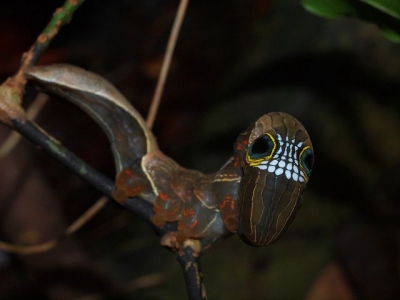
The Pink Underwing Moth Caterpillar in the Australian rainforest has a natural defence to scare off predators a set of teeth like markings set between spots that look like eyes with large pupils giving it the appearance of a skull-like face on its head.
Nature never ceases to astonish. This is the larva of the Pink Underwing Moth, an endangered species which lives in the subtropical rainforest below about 600m elevation in the Australian states of New South Wales and Queensland. It has evolved a remarkable set of patterns to ward off potential predators. A giant set of eyes would, you might think, be enough to warn off a bird looking for an easy lunch. Yet this caterpillar goes one step further. It appears to have a set of teeth which could rip any possible attacker to shreds. Why, then, is it so rare? You might think that with this sort of natural protection the species would be thriving everywhere. That might be true, if it were not for the fact that the caterpillar of the pink is something of a fussy eater. Prospective breeding habitats are restricted to places where the caterpillar’s sole food plant, a rainforest vine, Carronia multisepalea, grows in Australia’s eastern subtropical rainforests. The plant is rare, so likewise is the pink underwing. In fact the larva has only been found in six places.
When they hatch the caterpillars are at first a dull brown color. At this stage in their life cycle they rely on something called crypsis to avoid detection. It does this by having the appearance of a dried up leaf. Yet when it gets larger it relies as much on its markings as it does its ability to blend in. As the caterpillars grow they develop these two large eye spots bordered by thin yellow rings. Then there is that savage looking double row of white teeth on the dorsal side flanked by the eye spots. The most surprising thing, perhaps, is that these remarkable markings are at the larva’s bottom end, as it were. The real head is curled up, as are its legs. What we see is the anterior body segments raised up: as the skin stretches the markings are revealed. Enough to frighten away anything, one hopes.
Yet the Australian government is not sitting back and doing nothing. It plans to identify high priority sites and make sure that if these areas are on private land that they must be conserved. They are also providing people with information about habitat and encouraging the regeneration of the primary rainforest in which the moth lives. Let’s hope that this amazing species gets the support it needs to survive.
Credit : Arkin space
Picture Credit : Google




